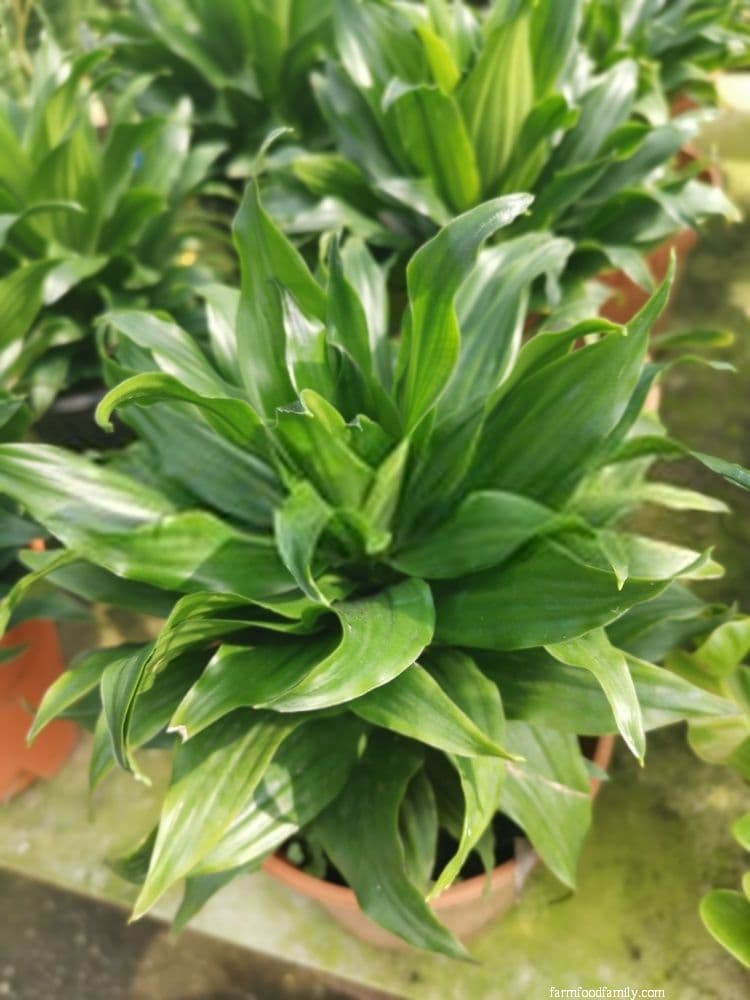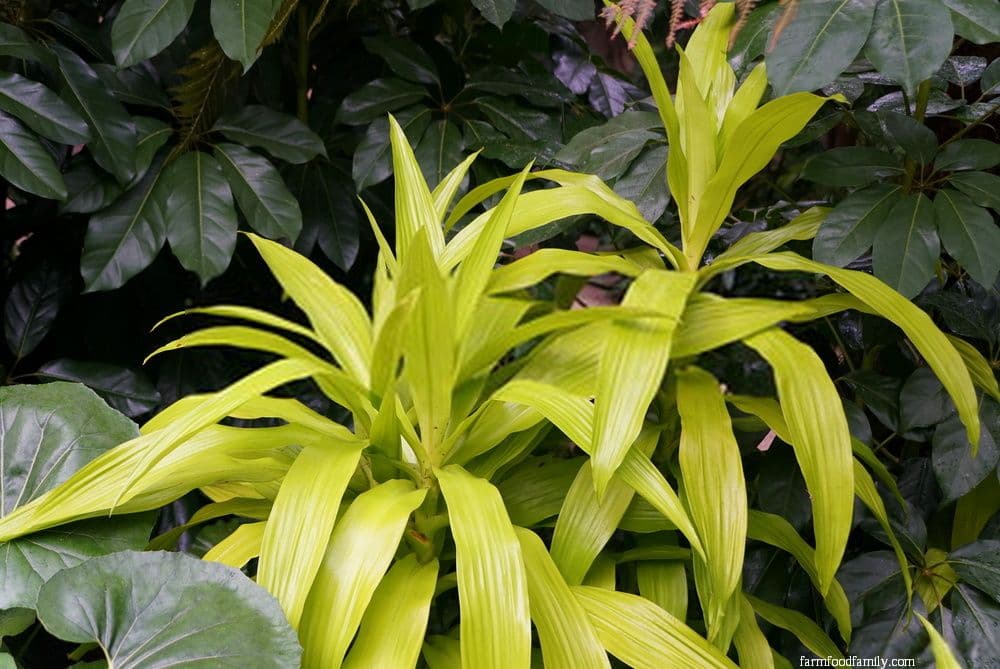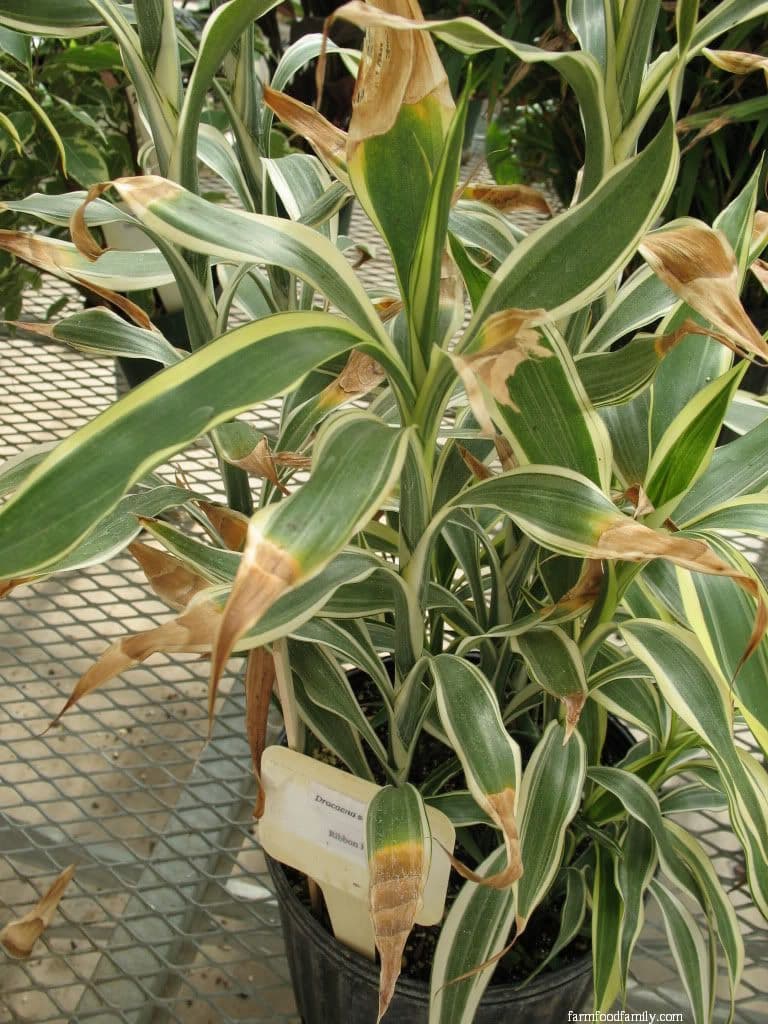Dracaena is a common houseplant. It is a low-maintenance indoor plant with foliage that comes in different colors, patterns, and even shapes, and size. Newbie plant lovers might not know that they are already looking at a dracaena because sometimes, it is confused with the fortune plant.
To avoid that confusion and for you to know more about this interesting houseplant, a roundup of the most popular and common dracaena varieties is featured in this post. Helpful information such as growth and caring guides are also available.

What is a dracaena plant?
The dracaena is considered as a tropical shrub and a popular low-maintenance and drought-tolerant houseplant. It thrives in bright lights but also in shaded, low-light areas.
The dracaena is known for its dense and bright colored foliage as well as its woody stems and drooping branches. Small dracaena plants are often featured in tabletops. Much interest is given to this houseplant because of its many attractive varieties.
Facts about Dracaena
Before we get serious about the dracaena plant, here are some interesting facts about this plant that you should know about:
- The name dracaena is a Greek term which translates to female dragon. It gets its name from the red gummy substance that oozes out from the stem when it is cut. The substance looks like dragon’s blood.
- Its red sap is historically used for making varnish paints by Italian violin makers in the 18th century.
- It can live for hundreds of years when it is left to thrive in its native habitat which would be dense woodlands.
- It is an iconic plant that grows specifically in limestone cliffs in Socotra Island, an island along the Indian Ocean near Yemen.
- The dracaena plant is a distant cousin of the famous asparagus.
- Its sap, stems, and leaves can be toxic to pets and humans.
- The dracaena is a natural air purifier.
Related:
- 20 Living Room Plants To Dress Up Your Space
- 10 Best Houseplants For Depression
- House Plants for Health: Indoor Plants Improve Air Quality
What do Dracaenas look like?
The dracaena can be easily spotted with its dense and glossy foliage in colors of green and white, green, and yellow, with flecks of red. It is bushy and woody, has brown stems with a secondary meristem which help the plant to grow dense.
How to identify a dracaena
The first identifier of the dracaena is its oval to long, sometimes drooping, sometimes lancing or strappy leaves. The foliage is dense and variegated, ranging from solid green, yellow, and sometimes striped. Other than this, you can also spot it with its woody brown or reddish stems with equally reddish veins.
Because it comes with many variegations, it might be hard to identify one, but each would have its own defining characteristics to check out.
Types of Dracaena
To differentiate which dracaena is which, here are the types of the plant to look out for. As have been mentioned, there are defining characteristics for each that separates them from the rest. These are the features that one should look for to get the best dracaena plant for you.
Dracaena Fragrans (syn. Dracaena Deremensis)

This one is also called the corn plant. It has a dense foliage, glossy, broad, and lancing dark green leaves. It has green stems that look like thick canes.
It thrives well in shade but could also tolerate indirect light. It also has a similar growth habit to that of palms that is why they are also called false palms. It can grow to up to 6ft tall in containers.
2. Dorado Dracaena (Dracaena fragrans ‘Dorado’)

The Dorado is unique from other dracaena species because has a finer foliage with coarse texture. Its leaves are bluish-green that looks like swords.
It produces cream flowers in the spring and orange berries during summer. It grows to up to 4ft indoors with a spread of 1.5ft. As such, it needs regular trimming for it to look neat always.
3. Dracaena ‘Janet Craig’ (Dracaena fragrans ‘Janet Craig’)

This one is popular for offices, homes or for mass planting in garden beds. It thrives well in filtered light. It has tapered, pleated-looking dark green foliage with wavy edges.
They can grow to up to 3ft in containers and up to 8ft in landscape beds. This one cannot tolerate heat and would wilt or die at above 95F.
4. Dracaena ‘Janet Craig’ Compacta

It is also called the pineapple dracaena because of its bushy, oval shaped, and long yellow green leaves that resonate that of pineapples. The name compacta on the other hand is taken from its being a small dracaena plant.
It is a favorite houseplant because it can survive in very dark areas. It is a slow grower that could reach a max height of 6ft.
5. Dracaena fragrans ‘Bausei‘ (Corn Plant)

This one has long, lancing leaves that grow to up to 2ft in length. The leaves cling on broad, woody stems. This plant can have a maximum height of 4ft when grown in containers. The bright green leaves sport a single, creamy center/stripe running through its length.
6. Dracaena fragrans ‘Lindenii’

This one also has the same glossy, dark green leaves of the Massangeana. It has a white stripe on the center and the leaves follow an arching habit. It thrives in indirect light and does not survive temperatures above 70F. It needs regular pruning for it to maintain its 3ft container height.
7. Dracaena fragrans ‘Victoria’

This one has an uncanny resemblance with the Massangeana because they share the same yellow stripe at the center, running through each lush green, sword-like leaves.
The only difference is that the Victoria has smaller leaves, but wider and triangular in shape. It grows to up to 4ft in containers. This one is very rare to find in local nurseries.
8. Dracaena Lisa (Dracaena fragrans ‘Lisa’)

This one is distinct for its broad, woody branches and tubular trunks. It looks like the yucca palm, with the same shiny, dark green leaves, spilling down. It grows to up to 5ft so if you need a bright focal point in your living room, this one is a good dracaena choice.
9. Hawaiian Sunshine Dracaena (Dracaena fragrans ‘Hawaiian Sunshine’)

This one is a cousin of Lisa. It is a new cultivar derived from another dracaena called Hilo girl. It is sometimes confused with the corn plant but this one has longer leaves with a distinct light green stripe running through the leaves’ center. It can grow to up to 4ft in containers.
10. Lemon Lime Dracaena (Dracaena fragrans ‘Lemon Lime’)

This one is a close cousin of Janet Craig and the Warneckii. It has lancing, sword-like leaves, with a lush green color and yellow stripes. The foliage forms a rosette form, making a bushy look. Its stems are woody, and the plant could grow to up to 5ft. If you need extra brightness in your room, this is the dracaena for you.
11. Lemon Surprise Dracaena (Dracaena fragrans ‘Lemon Surprise’)

True to its name, this one has broad, neon yellow leaves with green stripes with wavy edges. It could reach up to 7ft but could be contained in tabletops through regular pruning (which when done achieves only a max of 3ft).
It needs bright indirect light. It also has an upright growth form which is perfect for interior plantings.
12. Limelight Dracaena (Dracaena fragrans ‘Limelight’)

Also called as cornstalk dracaena, this one also has broad neon yellow leaves, with unbranched stems, forming a rosette. It grows to up to 6ft tall and can occasionally bloom tiny, white flowers in the summer. It is frost-resistant, drought resistant and is not vulnerable to common dracaena diseases.
13. Warneckii Dracaena (Dracaena fragrans ‘Warneckii’)

This one can thrive with low light and low water. It is loved for its upright growth, broad leaves that are pale green in color with white flecks and cream margins.
The leaves grow out in random directions, dangling sturdily along the stems. It grows to up to 5ft, making it a beautiful large indoor plant that is low-maintenance.
14. Dracaena Massangeana (Mass Cane)

This is a slow-growing dracaena that thrives in low light and minimal water. It looks like the crossover between cane and corn that comes with a woodier stem.
It is known for its arching, sword-like leaves with a band of gold center and bordered by lush green edges. It is perfect for small offices as it only grows to up to 3ft in containers.
15. Dracaena Marginata (Red Edged Dracaena or Dragon Tree)

This one is one of the most regal looking dracaenas existing. It is popular for its dark green, long, and narrow leaves with a lancing habit and crimson margins. It could reach up to 6ft and is drought tolerant.
This slow-growing dracaena is also a favorite houseplant because its stems are malleable which means that it can be twisted, turned and shaped into different forms.
16. Dracaena Marginata ‘Tricolor’

This one might be preferred indoors but it is more attractive as garden bed plants outdoors. True to its name, its long, and very slim, lancing leaves have red edges, green second layer, and a white stripe running down to its center. It is hardy, drought resistant and thrives well in dense shades and filtered light.
Dracaena Reflexa

It was originally called as the pleomele and is the mother plant of the dracaena cultivars Song of Jamaica and Song of India. Its foliage is broader than marginata but their appearance are almost the same.
It has green leaves with cream borders. It grows slowly and achieves a height of 3ft. Sometimes, it produces tiny white flowers in spring.
17. Dracaena Song of India (Dracaena Reflexa ‘Variegata’)

This one is one for its unique striped leaves green and yellow (or cream). The leaves are long and follow a star-shape growing habit. It is bushier than most dracaena, loves humidity and thrives in indirect light. When grown right, it produces small, yellow, or white flowers. This one is drought resistant.
18. Song of Jamaica (Dracaena Reflexa ‘Song of Jamaica’)

This one is distinct because its dense foliage seems to cluster in different levels in the woody stem, creating whorls of lime green leaves. It is multi-stemmed, grows better outdoors (reaching to up to 12ft), and is perfect for tropical gardens. In potted containers, it grows to up to 3ft.
19. Florida Beauty Dracaena (Dracaena Surculosa ‘Florida Beauty’)

Aside from being smaller in size than most dracaena plants, it is also shrubbier than the rest of them. This one is one of those spotted dracaenas, with a max height of less than 2ft. Its broad leaves are deep green in the edges with spots of yellow and creamy white all over.
20. Gold Dust (Dracaena surculosa ‘Gold Dust’)

This one is distinct from other dracaenas because of its oval shaped leaves. It is also called the spotted dracaena because of its white and yellow spots all over its glossy leaves. Its stems are very thin, somewhat resonating bamboo stems. When grown properly, it blooms white flowers during spring.
21. Lucky Bamboo (Dracaena Sanderiana)

This one is a common dracaena but you would not have known that it is a species of the plant until now. Aside from being good ornamental plants, it is also versatile as the stems could be braided or shaped in spirals. It only reaches one foot. It is often placed in water tanks with lots of pebbles. If planted in soil, it needs damp and well-draining ones.
22. Ribbon Plant (Dracaena sanderiana Variegata ‘Ribbon Plant’)

This one is a flowering dracaena and is also called the friendship bamboo. It has upright, cane-like stems, with well-spaced ovate, bright green leaves with curvy edges. It grows to up to 5ft in containers. It thrives in filtered light.
23. Dracaena Arborea

This one is also called the Tree Dracaena and is more well-suited outdoors. It thrives in semi-desert environments, looks like a palm tree with its broad trunk, woody branches, and stiff, glossy leaves. It also comes with multiple heads, forming a dense crown. It is an attractive landscape plant that is drought-tolerant and low maintenance.
24. Snake Plant (Dracaena Trifasciata)

It is also known as the Mother-in-Law’s tongue. It is usually used as ground cover or as filler plants in garden beds. It is very hard to endure drought, cold temps, and high humidity.
The leaves look like a snake’s skin, leathery in texture with wavy patterns of yellow, green, and cream. It grows flat and upright to up to 4ft. It could be poisonous to animals and humans.
25. Zebra Striped Dragon Tree (Dracaena ‘Goldieana’)

Also called as the Green Zebra plant, it is distinct for its oval and pointed leaves with horizontal cream stripes and deep green bands all over. When maintained well, it produces bell shaped flowers emerging from its succulent stems. It grows to up to 6ft in the wild and can tolerate temperatures of up to 18C.
Related: Types of succulents with pictures
26. Dracaena Rikki (Dracaena deremensis “Rikki”)

This one is a new cultivar and is the cousin of Janet Craig, Compacta, and Warneckii. It is distinct with its dark green, sword-like leaves with yellow stripes running through its length. It has an arching habit and a height that could reach 12ft. It is hardy, low-maintenance, and is suitable for tropical climates.
27. Dracaena cinnabari (Dragon blood tree)

It is also called the Socotra dracaena and was found in alleged dragon bone remnants in Socotra Island. It produces red saps that look like blood. It is cultivated for its resin from the broad trunks and is used in many commercial purposes.
It is more of a majestic tree than a container plant. It grows to up to 9m with dense, fine, needle-like leaves that grow exclusively upright.
How tall do dracaena plants grow?
Dracaena plants grow in the wild in a range of 6-12ft. As container plants, the height can become manageable to as low as 4ft (which can be done through regular pruning). Regular pruning also makes the dracaena plant bushier in look.
How to grow and care for a dracaena plant
If you are considering having a dracaena plant around, here are the things that you should be familiar with in terms of care requirements:
- Water: They do not need regular watering. Misting is more beneficial than watering as a matter of fact. They are prone to rot when overwatered. Do some misting once a week.
- Light: Dracaena plants thrive well in filtered light or in partial to full shade areas. Direct bright light in long exposures scorch the leaves of this plant.
- Temperature: The best temperature range for this plant to grow is not more than 80F during the day and not less than 55F at night. It thrives well too in common room humidity.
- Fertilizer: Common dracaena plants can survive even without fertilizer. New cultivars and hybrids could benefit from fertilizing during the first months of growth.
How to save a dying dracaena plant
The main causes of a drying dracaena plant are too low or too much water. These could be manifested by browning leaves or rotting stems. To save it from dying, you can amend the soil, replant it, check if the soil is too moist or too dry and do the necessary interventions. You can also add fertilizer.
Why are my dracaena leaves turning brown?
Chances are, the leaves of your dracaena are turning brown because of overwintering, moist, underwatering and too much exposure to bright, direct light.
Are Dracaena good house plants?
Yes, and for a lot of reasons. One, they are low-maintenance plants. Two, they are drought tolerant and easy to grow. Three, they tolerate various growing conditions. Four, they provide bright spaces in the home and act as natural air purifiers.
What grows well with dracaena?
The best plants to grow with dracaena would be medium blooming annuals and more flashy perennials. These categories include impatiens, creeping jenny, coral bells, and petunias.

